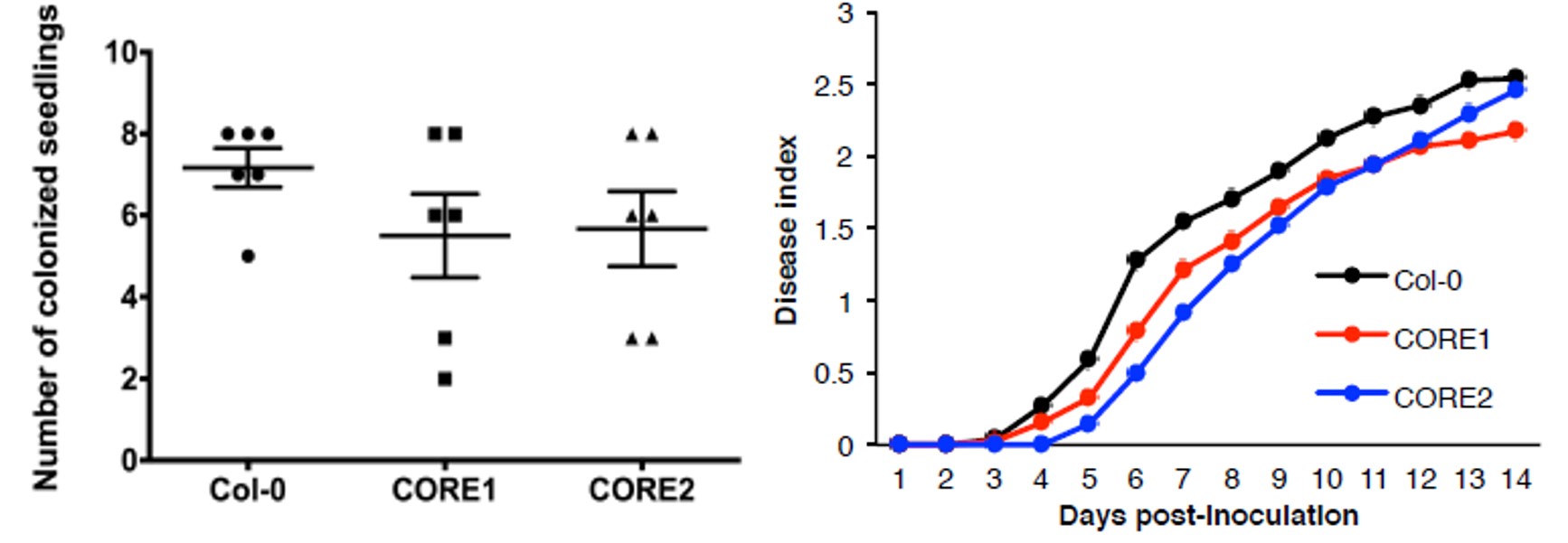New study identifies a potential source of resistance against the devastating crop disease bacterial wilt
Plant diseases caused by bacterial pathogens pose an important threat to food security worldwide. Ralstonia solanacearum, the causal agent of the bacterial wilt disease, is considered the most destructive plant pathogenic bacterium due to its lethality, persistence, wide host range and broad geographic distribution. R. solanacearum affects over 250 plant species in over 50 families, including important crops such as potato, tomato, tobacco, banana, pepper and eggplant, among others, being responsible for enormous economic losses.
The plant immune system is capable of detecting conserved bacterial molecules, which act as a tell-tale for the presence of invading bacteria. When this happens, immune responses get activated to prevent the development of a disease. The best studied case is that of flagellin, the protein that forms the bacterial flagellum (a structure that many bacteria use as a propeller to move). Plants have evolved immune receptors to detect different parts of bacterial flagellin and activate the plant immune system upon bacterial invasion. Since most bacterial pathogens need the flagellum to move and cause disease, plants can easily detect this molecule as indication of bacterial presence, and a potential loss of the flagellum to evade this recognition would render a bacterium motionless and non-infecting.
Recently, a study led by Dr. Alberto Macho at the Shanghai Center for Plant Stress Biology uncovered that R. solanacearum has evolved to modify its flagellum to make it undetectable by immune receptors in plants from the Solanaceae family (potato, tomato, pepper, and eggplant, among others), which comprise most economically important crops affected by R. solanacearum. However, the same study revealed that several species from this same family (for example, tomato and tobacco) can perceive another molecule present in R. solanacearum, named Cold-Shock Protein (CSP). CSP is a protein produced in bacteria under stressful conditions, such as exposure to unfavourable environmental conditions or during the plant infection. Specific plants, such as tomato and tobacco, have in turn developed an immune receptor, named CORE, which perceives bacterial CSP and activates the plant immune system. However, other plant species, lacking CORE, are not able to detect bacterial CSP. Notably, treatment with purified CSP from R. solanacearum increases resistance to bacterial wilt disease in tomato plants. Moreover, transgenic expression of the CORE receptor in the model plant Arabidopsis thaliana, which naturally lacks it, renders this plant more resistant to infection by R. solanacearum.
This work uncovers the first molecule from Ralstonia perceived by Solanaceae plants and the corresponding receptor, and suggests that the inter-family transfer of this receptor to non-responsive plant species could increase the resistance of economically relevant crop species against bacterial wilt disease. Importantly, non-Solanaceae plants and several agronomically important solanaceous plants cannot perceive CSP. Transgenic approaches will now allow for the transfer of the CORE receptor to such plant species, generating an additional layer of resistance against R. solanacearum, and will contribute to current efforts to fight against bacterial wilt in crop plants.
The study was recently published in Plant Biotechnology Journal, and it has been funded by the Chinese Academy of Sciences, the National Natural Science Foundation of China.
Wei Y., Caceres-Moreno C., Jimenez-Gongora T., Wang K., Sang Y., Lozano-Duran R. and Macho A.P. The Ralstonia solanacearum csp22 peptide, but not flagellin-derived peptides, is perceived by plants from the Solanaceae family. Plant Biotechnology Journal (2017)

Expression of Nicotiana benthamiana CORE (NbCORE) or tomato CORE (SlCORE) enhance responsiveness to Ralstonia csp22 in Solanaceae plants.
 Arabidopsis
Arabidopsis transgenic lines expressing the tomato CORE receptor gain responsiveness to
Ralstonia csp22 and become more resistant to
Ralstonia infection.
Contact:
Prof. Alberto Macho
Shanghai Center for Plant Stress Biology (PSC), CAS
Tel: (86) 21- 57078218
Email: alberto.macho@sibs.ac.cn

